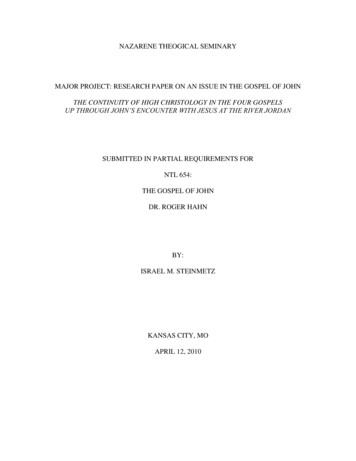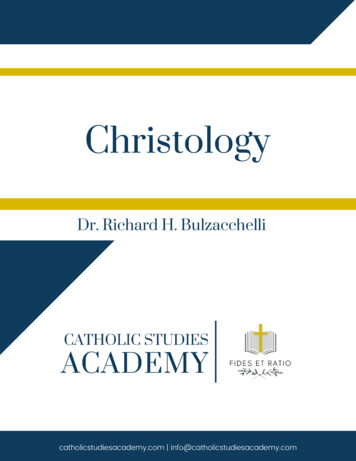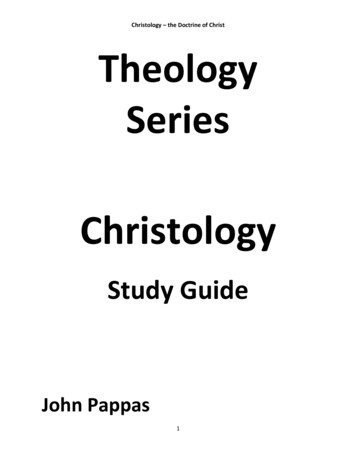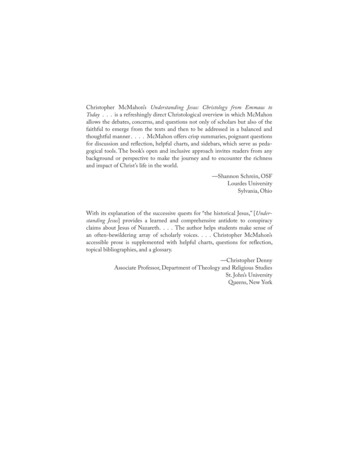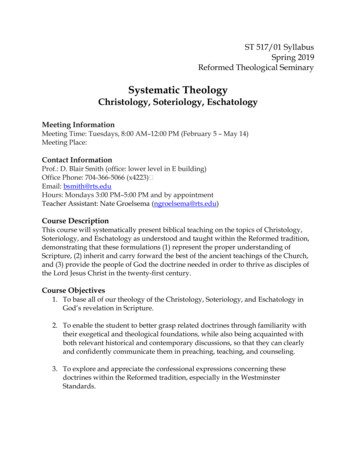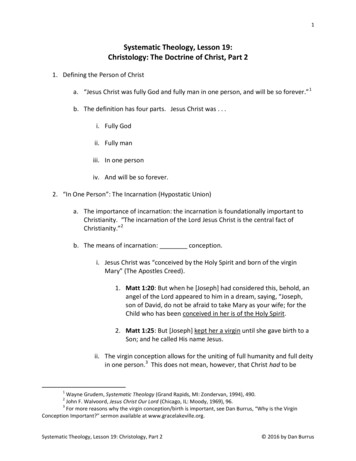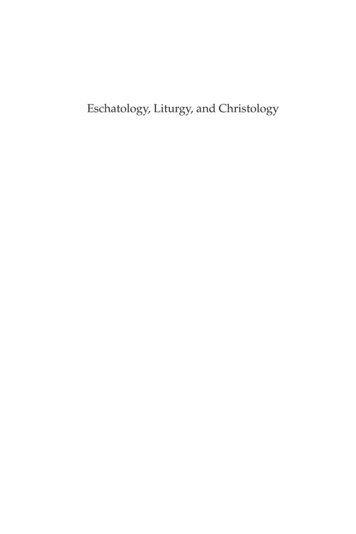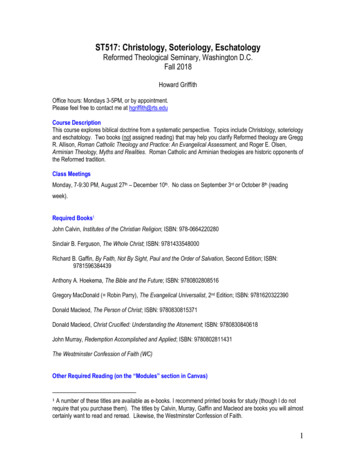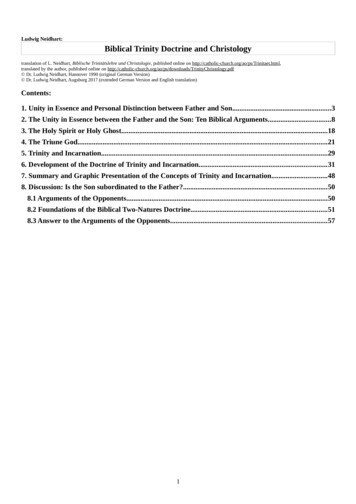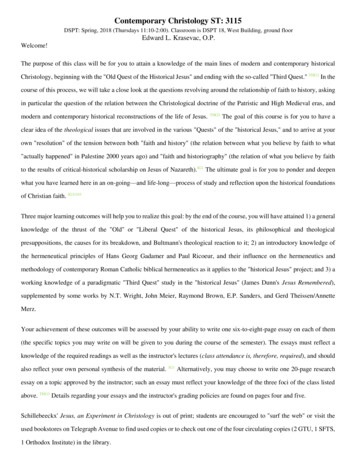
Transcription
Contemporary Christology ST: 3115DSPT: Spring, 2018 (Thursdays 11:10-2:00). Classroom is DSPT 18, West Building, ground floorEdward L. Krasevac, O.P.Welcome!The purpose of this class will be for you to attain a knowledge of the main lines of modern and contemporary historicalChristology, beginning with the "Old Quest of the Historical Jesus" and ending with the so-called "Third Quest." THG2 In thecourse of this process, we will take a close look at the questions revolving around the relationship of faith to history, askingin particular the question of the relation between the Christological doctrine of the Patristic and High Medieval eras, andmodern and contemporary historical reconstructions of the life of Jesus.THG5The goal of this course is for you to have aclear idea of the theological issues that are involved in the various "Quests" of the "historical Jesus," and to arrive at yourown "resolution" of the tension between both "faith and history" (the relation between what you believe by faith to what"actually happened" in Palestine 2000 years ago) and "faith and historiography" (the relation of what you believe by faithto the results of critical-historical scholarship on Jesus of Nazareth).IG1 The ultimate goal is for you to ponder and deepenwhat you have learned here in an on-going—and life-long—process of study and reflection upon the historical foundationsof Christian faith. IG3/103Three major learning outcomes will help you to realize this goal: by the end of the course, you will have attained 1) a generalknowledge of the thrust of the "Old" or "Liberal Quest" of the historical Jesus, its philosophical and theologicalpresuppositions, the causes for its breakdown, and Bultmann's theological reaction to it; 2) an introductory knowledge ofthe hermeneutical principles of Hans Georg Gadamer and Paul Ricoeur, and their influence on the hermeneutics andmethodology of contemporary Roman Catholic biblical hermeneutics as it applies to the "historical Jesus" project; and 3) aworking knowledge of a paradigmatic "Third Quest" study in the "historical Jesus" (James Dunn's Jesus Remembered),supplemented by some works by N.T. Wright, John Meier, Raymond Brown, E.P. Sanders, and Gerd Theissen/AnnetteMerz.Your achievement of these outcomes will be assessed by your ability to write one six-to-eight-page essay on each of them(the specific topics you may write on will be given to you during the course of the semester). The essays must reflect aknowledge of the required readings as well as the instructor's lectures (class attendance is, therefore, required), and shouldalso reflect your own personal synthesis of the material.IG1Alternatively, you may choose to write one 20-page researchessay on a topic approved by the instructor; such an essay must reflect your knowledge of the three foci of the class listedabove. THG3 Details regarding your essays and the instructor's grading policies are found on pages four and five.Schillebeeckx' Jesus, an Experiment in Christology is out of print; students are encouraged to "surf the web" or visit theused bookstores on Telegraph Avenue to find used copies or to check out one of the four circulating copies (2 GTU, 1 SFTS,1 Orthodox Institute) in the library.
The primary pedagogical method for this course is lecture. However, questions and comments relevant to the lectures orreadings, and the discussions that flow from them, are always welcome.IG4/THG4/IG2Please keep your questions short andfocused, however, realizing that others may also need the floor, and avoid polemical formulations or those that are disrespectfulof others, always realizing that we search for understanding with humility, rather than with the intellectual arrogance of thosewho believe that they have little to learn. IG2This will introduce you to a number of concepts that you are encouraged to pursue in the years which follow; this is onereason why the syllabus contains more material than you will be expected to read during the course itself (as we proceed, Iwill suggest the most important readings for any given class, as well as those that would be appropriate for future reference).The process of your understanding and integration of this material can only begin in this course, but must continue wellbeyond it; although I will foster this process as best I can, the responsibility for this integration is primarily yours, both nowand in the future. IG3/IO3Details on assignments and grading will be found in the following pages. Note that the reading assignments are given withno dates attached; they should be read in sequence, depending upon how far we get on any particular day.Instructor:Edward Krasevac, O.P., Professor of TheologyB.A. Philosophy, Santa Clara University; M.A. Philosophy, St. Albert s College; M.Div., Dominican School of Philosophy and Theology; S.T. Lic., Jesuit School ofTheology, Berkeley; Ph.D., Graduate Theological Union.Office Address: DSPT (corner of Vine & Arch), East Building, Second Floor, Room 200 (at far end).Office Hours: Office Hours: Mondays 8:00-9:30 and 11:00-12:00, and by appointment.E-Mail (best way to contact me): ekrasevac@dspt.edu/Telephone: 883-2082Please check your email on a daily basis; this is the primary way in which I will communicate with you regarding changesof reading assignments or in the event a class has to be canceled due to illness. If your email address changes during thesemester, please notify me immediately.Class will not be held on during Spring Recess (3/24), and perhaps not during the last week of class (5/19).If you will need special arrangements for meeting course requirements for reasons of documented disability, please speak to theinstructor early in the term so that arrangements can be anticipated and arranged. Students who have trouble climbing the stairs to myoffice may meet with me in a designated ADA room on the first level of the East Building.
Asterisks indicate that the readings are in the class readers (One and Two) available at Copy Central on Heart at EuclidTHE MODERN "PROBLEM OF THE HISTORICAL JESUS"Old Quest and its Breakdown in Schweitzer & Weiss / Wrede / Kahler / Troeltsch (2 classes)Mark Allan Powell, Jesus as a Figure in History (Second Edition), Chapter 1, pp. 10-18 and 26-27 (Wrede)**James Mackey, Jesus, the Man and the Myth, pp. 18-23 / 30-49*Two pages of slightly different outlines on the three quests entitled "Questing for Jesus: A Summary"*One two column page entitled "Modernity"*Two-page Outline of Schweitzer's Quest of the Historical Jesus*One page entitled "Harvey, Van. The Historian and the Believer.*One page entitled "Peter Burke, The Renaissance Sense of the Past.*Two pages of quotations from Gordon Michalson's Lessing's Ugly Ditch*Five pages of quotations from Allister McGrath's The Making of Modern German Christology*One page of quotations entitled "Ritschl"*One page entitled ADOLF VON HARNACK (1900). Das Wesens des Christentums*Two pages on the Basic Principles of the Enlightenment and the breakdown of the Old Quest'*One page entitled "The Messianic Secret"*One page entitled "Schweitzer on Johannes Weiss"*Two pages of quotes from Schweitzer's The Quest of the Historical Jesus*Two pages entitled "PRINCIPLE OF CRITICISM" on Troeltsch's three principlesJames Dunn, Jesus Remembered, pp. 71-73 (on Kahler and faith's "storm-free zone")*One page entitled "Aftermath of the Old or Liberal Quest"*One page entitled "TREES INTHE FOREST"Dialectical Theology ( class)**Rudolf Bultmann, "New Testament and Mythology," in Kerygma & Myth.James Dunn, Jesus Remembered, pp. 73-78 (on Bultmann)*Two pages entitled "FORM CRITICISM"*One page of texts from Karl Barth's Word of God and Word of Man Edward Krasevac, "Between the Scylla and Charybdis of Faith and Fact" handed out in classNew Quest (honorable mention only)Mark Allan Powell, Jesus as a Figure in History (Second Edition), Chapter 1, pp. 19-22 (New Quest)James Dunn, Jesus Remembered, pp. 78-81 1*One page with handwritten "New Quest" at the topHERMENEUTICS AND HISTORICAL METHODOLOGY: Gadamer / Habermas / Ricoeur / Schillebeeckx (3 classes)*Two pages of quotations entitled "The Hermeneutical Circle" (see Dunn, Jesus Remembered, pp. 118-123)*Ten pages of typed text entitled "Excerpts from Gadamer's Truth and Method"*Thirteen pages of typed text beginning with the page entitled "HANS GEORG GADAMER: Excerpts from James DiCenso,Hermeneutics and the Disclosure of Truth."*One page on wirkungsgeschichte and wirkungsgeschichtliches Bewusstsein*One page entitled "EFFECTIVE HISTORY, HISTORICAL CONSCIOUSNESS", etc.*Three pages of typed text from Georgia Warnke's Gadamer: Hermeneutics, Tradition and Reason*Two pages of texts from Anthony Thiselton*Schillebeeckx, The Understanding of Faith, pp. 128 130.*Two pages of typed text from Paul Ricoeur, "Hermeneutics and the Critique of Ideology"*Two pages entitled "IDEOLOGY"*One page entitled "HERMENEUTICAL THEORY of PAUL RICOEUR" by Roger Haight*One page entitled "Foundationalism"*Three pages of quotations from Thomas Guarino, "Between Foundationalism and Nihilism: Is Phronesis the Via Media forTheology?", lines 1 78 and 115 156*Two pages of quotations from Gaurino's, "Postmodernity and Five Fundamental Theological Issues."*Two pages of quotations entitled "Excerpts from Thomas Guarino, "Betti and the Hermeneutics of Dogma"*Two pages entitled "Summary of Key Ideas from Sandra Schneiders, The Revelatory Text
*One page entitled "WORLD BEHIND THE TEXT"*One page entitled "SENSES OF SCRIPTURE: Raymond Brown Schillebeeckx, Jesus, an Experiment in Christology, pp. 17-88 (89-102 recommended)*One page of texts entitled Mary Catherine Hilkert, O.P. "Hermeneutics of History. . . . "*Five pages of quotes beginning with SCHILLEBEECKX: THE HERMENEUTICAL PROBLEM IN REGARD TO THE PAST*Two-page synthesis of Jesus, pp. 575-94; recommended: Jesus, pp. 575-94*One page entitled "Texts on Revelation and Interpretation"*Two pages entitled "THE CREDIBILITY OF FAITH"*One page entitled "Karl Rahner, Foundations of Christian Faith" on hermeneutics and fundamental theology Krasevac, "Questing for Jesus: Need We Continue?" handed out in classMark Allan Powell, Jesus as a Figure in History (Second Edition), pp. 59-71 and 24 bottom–25 (Allison on memory)*One page entitled "Criteria for Uncovering Historical Jesus"*One page entitled "Criterion of Embarrassment" and a second entitled "164 Part II: Profile of a Prophet"Mark Allan Powell, Jesus as a Figure in History (Second Edition), Chapter 2, pp. 34-37 / 43-59OR James Dunn,Jesus Remembered, Chapter 7, on sourcesHISTORICAL CHRISTOLOGY: JAMES DUNN, JESUS REMEMBERED (5 1/2 classes [140 pages of text per class])Dunn, Chapter 1, entireDunn, Chapter 4, pp. 26-29Dunn, Chapter 6, pp. 99-105 / 107-11 / 115-123 / 126-31Dunn, Chapter 8, pp. 199-204 / 209-24 / 239-41 / 245-9Dunn, Chapter 9, entire**Theissen, The Historical Jesus, Chapter 5, pp. 125-29 / 132-37 / 146-47 [Jewish background, esp. Pharisees, Essences, and Sadducees]**Theissen, The Historical Jesus, Chapter 8, pp. 225-37 [opponents of Jesus: Scribes, Herodians, Pharisees, Essenes, Sadducees]**Craig Keener, The Historical Jesus of the Gospels, pp. 223-24 / 232-4 and**John Meier, A Marginal Jew, Vol 3, pp. 311-21 / 330 / 335-9 /// Vol. 4, pp. 342-49 / 385 / 392-3 / 397 / 399 / 411-15Dunn, Chapter 10, entireDunn, Chapter 11, entire*One page of Old Testament passages regarding the "eschatological prophet"*One page from John Meier entitled "Passages from A Marginal Jew on the Eschatological Prophet*Two pages of quotations by Raymond Brown on the Infancy Narratives, "theologoumena," and "verisimilitude"*One page on the dating of the ministry of Jesus according to John Meier*Two pages of texts from John Meier's A Marginal Jew ("Roots of the Person")Dunn, Chapter 12, pp. 383-467*Two pages entitled "Apocalyptic"*One page entitled "Beatitudes"Dunn, Chapter 13, entire*Three pages of texts entitled TABLE FELLOWSHIP / PURITY / SINNERS**Craig Keener, The Historical Jesus of the Gospels, pp. 203-13Dunn, Chapter 14, entire**Theissen, The Historical Jesus, Chapter 12, pp. 347-48 / 361-72 [Jesus and the Torah]*One page from John Meier on Jesus' saying on divorce*Two pages of texts from John Meier entitled "Texts on Double Commandment of Love"*Three pages of quotes from Meier entitled "Some of the sayings that have a good probability of being words of the 'earthly'Jesus, using historiographical criteria"**Craig Keener, The Historical Jesus of the Gospels, pp. 214-18Dunn, Chapter 15, pp. 615-6 / 628-704**Theissen, The Historical Jesus, Chapter 16, pp. 523-4 and 560-63 [implicit Christology and authority of Jesus]Dunn, Chapter 16, pp. 705-26 / 759-62Dunn, Chapter 17, entire**Theissen, The Historical Jesus, Chapter 4, pp. 106-8 (#8) ["Explanatory" versus "productive" use of scripture in the New Testament]
*One page of quotes from Brown's, The Death of the Messiah, entitled "Temple Threats"*Three pages of historical memories in the tradition of the Passion Narratives from Brown's, The Death of the Messiah**Theissen, The Historical Jesus, Chapter 13, pp. 421-37 [The Last Supper]**Theissen, The Historical Jesus, Chapter 14, pp. 458-69 [Passion]Dunn, Chapter 18, pp. 825-40**N.T. Wright, The Resurrection of the Son of God, pp. 7 (2nd ) / 10 (2nd ) / 12 13 ("The Senses of History") / 23-9 (1st )/ 30 (4th ) 31 / 82 3 / 121 4 / 200 5 / 381 83 / 395 / 477 / 598 608 / 613 (2nd ) / 628 / 681 (2nd ) / 685 96 / 706 10 / 717*One page of typed quotations entitled "Walter Kasper's, Jesus the Christ, on Resurrection Appearances**Theissen, The Historical Jesus, Chapter 15, p. 503 [Resurrection appearances]Dunn, Chapter 19, entire**Theissen, The Historical Jesus, Retrospect: A Short Life of Jesus, pp. 569-72EDWARD SCHILLEBEECKX and WALTER KASPER [some Christological "loose ends"] (1/2 class)Jesus, pp. 545-58, 602-3 ( 2)OVERVIEW OF CONTEMPORARY DEVELOPMENTS: The Third Quest for the Historical Jesus (2 classes)Mark Allan Powell, Jesus as a Figure in History (Second Edition): Chapters 7, 8, 9, 10, and Chapter 3 on Horsley/Downing/Chilton.(Chapters 4 and 5 on the Jesus Seminar and Crossan are recommended).For Reference in Reader Number One (summaries of some important Third Quest books):*E. P. Sanders, The Historical Figure of Jesus and Jesus and Judaism (3 pages)*Gerd Theissen and Annette Merz, The Historical Jesus (3 pages)*Paula Fredriksen, Jesus of Nazareth, King of the Jews (4 pages)*N. T. Wright, Jesus and the Victory of God (5 pages)*John Dominic Crossan, The Historical Jesus criticisms from reviews (5 pages)*Marcus Borg, Conflict, Holiness and Politics in the Teachings of Jesus 1998 (3 pages)*Marcus Borg, Jesus in Contemporary Scholarship (1 page)*James Charlesworth and Walter Weaver, eds. Images of Jesus Today (1 page)* Luke Timothy Johnson, "The Real Jesus: Patterns and Narratives" (2 pages)*Methodology Texts from N.T. Wright, John Meier, and Luke Timothy Johnson (2 pages)REQUIRED BOOKS (see Addendum for further information) Mark Allan Powell, Jesus as a Figure in History, Second Edition James Dunn, Jesus Remembered Edward Schillebeeckx, Jesus, An Experiment in Christology (out of print: please search for used copies on the Internet; manyare available).READERS *Reader Number One [non-copyrighted readings] (available at Copy Central, on Heart just west of Euclid)Note: Reader Number One should always be brought to class **Reader Number Two [copyrighted readings] (available at Copy Central, on Heart just west of Euclid)
Course Requirements/Grades/Incompletes1.Written Essays: Three essays (each 6-8 pages in length) will be assigned during the semesterwhich will cover the three important segments of the class; although it is advisable that they bewritten when assigned and submitted in a timely fashion thereafter, they will not finally be due untilthe last day of the semester, May 18th. A total of 20 pages of written material is required for thecourse; there is no term paper or final exam.1 The point of these essays is to help you understand,critically assimilate and express the important issues covered in the course in a concise andsynthetic fashion; IG1/THG3 essays that are unable to do this in the allotted number of pages will bereturned for editing. Mistakes that show carelessness (such as typos, misspellings, sloppiness) arenot acceptable. Although the content of the written work is obviously of primary importance, thepresentation of that content is important as well, particularly for those who will have careers inpreaching or teaching. IG4/IO4 Proofread your work!2. Grades THO1 will be determined primarily by the quality of the written essays that of their content(how well they reflect your knowledge of the readings and lectures, your ability to recognize anddevelop the important principles contained in them, as well as your ability to think through thematerial synthetically) and their form (your ability to express in good written English, free ofsyntactical and grammatical error, what you know). In addition, attendance at all class sessions is arequirement for the course and will be a consideration in grading, and no credit for the class will begiven at all if a student misses more than three classes. IG4/I04/THG4 If you have previous commitmentsthat will cause you to miss classes, you probably should not enroll. Students are responsible for allmaterial discussed in class; if you miss a class due to illness, you should check with someone whowas present, or arrange for it to be recorded. Also, being late for a small class can be disruptive andannoying for everyone, as well as discourteous; please be prompt! IG33. Incompletes: If you have not turned in all of your essays by Friday, May 18th, you must submit the form totake an incomplete by then—essays turned in after Friday without taking an incomplete will lose one fullgrade. The DSPT policy on incompletes will be followed without exception: "Students who wish to take anIncomplete in a course must file a petition by the last day of the semester. The work for each course must becompleted by the third week after the end of the semester in which the course is taken." Work that issubmitted after the third week after the end of the semester will lose one full grade. IG3/IO34. Plagiarism. Always use quotation marks around others' phrases that you use in your essays, and citethe reference in a footnote or parentheses. An instance of plagiarism will automatically result in agrade of "F" for the course.5. ESL Students: If English is your second language, you may ask for and be given one extra week tocomplete each one of the essays; the final due date for all of them is still May 18th, however.1Alternatively, you may choose to write one 20-page research paper on a topic approved by the instructor; suchan essay must reflect your knowledge of the three foci of the class listed above, and should be written according tothe standards prescribed in the most recent edition of A Manual for the Writers of Term Papers, Theses andDissertations, by Kate Turabian.
AddendumRequired Books/Readers:Mark Allan Powell, Jesus as a Figure in History (ISBN 978-0664234478). Cost is 20.09 on Amazon.com as of1/1/16. Please consider purchasing it at the DSPT/Amazon bookstore atJames Dunn, Jesus Remembered (ISBN 978-0802839312) Cost is 50.49 on Amazon.com as of 1/1/16. Pleaseconsider purchasing it at the DSPT/Amazon bookstore atEdward Schillebeeckx, Jesus, An Experiment in Christology (ISBN 978-1587432231) (out of print: pleasesearch for used copies on the Internet; many are available).Readers One and Two are available for purchase at Copy Central, 48 Shattuck Square, at University Avenue. Theprecise cost has not yet been determined by Copy Central, as it is based on copyright fees, but the total for bothreaders in past years has been around 35.00). The phone number of Copy Central is 510-848-7034; you maywant to call to make certain they have copies prepared before you go in to pick one up.The official description of this course is found in the GTU Schedule of Classes: "This lecture course (designedfor the M.A./M.Div./M.T.S. levels) will trace the modern development of the various "Quests of the HistoricalJesus" (First, Second, Third), with particular emphasis on Edward Schillebeeckx' hermeneutical and theologicalprinciples and James Dunn's historical Christology, as well as on several other important "Third Quest" figures(Crossan, Brown, Meier, Wright, Theissen, and Sanders). Requirements for the class are regular attendance, and20 pages of writing (to be distributed over three essays assigned by the instructor). The prerequisite for the class isto have completed ST2232 (Historical Development of Christology) or its equivalent (work assuring a fairlycomprehensive knowledge of the Patristic/conciliar development of Christology from Ignatius of Antioch throughConstantinople III, and of Aquinas' understanding of the hypostatic union in the framework of his metaphysics of"esse")."
General Criteria for Grading of PapersA:Not only does the student's work reflect a correct understanding of the subject matter, but his orher efforts show something more: a certain and marked depth of understanding of the subjectwhich allows its wider implications to be grasped and creatively applied to other areas of thoughtand life, an ability to discern and articulate the principles involved, as well as a talent to expressoneself with both clarity and power. The writing is both fluent and without grammatical orsyntactical error, and follows the standards prescribed in the most recent edition of A Manual forthe Writers of Term Papers, Theses and Dissertations, by Kate Turabian.A-:For work that falls somewhat short of the above.B :The student has demonstrated that he or she has correctly grasped the subject matter, free of error,and has expressed it articulately and well.B:The student has correctly grasped the subject matter, and has articulated it in such a way that thisis obvious to the instructor.B-:Although the work shows a fundamental and a good understanding of the subject matter, someerrors in understanding have been made, or perhaps the expression is such that some confusionresults when it is read.C :The students work shows effort, and some real understanding of the subject matter. However,there are some important errors or omissions, or the expression may make it difficult to determinejust what the student indeed has grasped.C:Again, effort has been demonstrated, but there are some serious errors or omissions that showthat the student has not grasped important aspects of the subject matter, or has expressed them sopoorly as to leave a serious question in that regard.C-:The work is poor, in both understanding and expression, but effort to understand has beendemonstrated.D Not only is the work poorly done and poorly expressed, but it is obviousDthat the effort normally expected of a student has simply not beenD-made. This would include poor class attendance.F:The assignments have not been turned in and there has been poor class attendance.
READER NUMBER ONE AVAILABLE AT COPY CENTRAL (on Hearst Avenue, just west of Euclid)*Two pages of slightly different outlines on the three quests entitled "Questing for Jesus: A Summary"*One two column page entitled "Modernity"*Two page Outline of Schweitzer's Quest of the Historical Jesus*One page entitled "Harvey, Van. The Historian and the Believer.*One page entitled "Peter Burke, The Renaissance Sense of the Past.*Four pages of quotations from Gordon Michalson's Lessing's Ugly Ditch*Five pages of quotations from Alister McGrath's The Making of Modern German Christology*One page of quotations entitled "Ritschl"*One page entitled ADOLF VON HARNACK (1900). Das Wesens des Christentums*Two pages on the Basic Principles of the Enlightenment and the breakdown of the Old Quest'*One page entitled "The Messianic Secret""One page entitled "Schweitzer on Johannes Weiss"*Two pages of quotes from Schweitzer's The Quest of the Historical Jesus*Two pages entitled "PRINCIPLE OF CRITICISM" on Troeltsch's three principles*One page entitled "Aftermath of the Old or Liberal Quest"*One page entitled TREES IN THE FOREST*Two pages entitled "FORM CRITICISM"*One page of texts from Karl Barth's Word of God and Word of Man*One page with handwritten "New Quest" at the top*Two pages of quotations entitled "The Hermeneutical Circle" (see Dunn, Jesus Remembered, pp. 118-123)Ten pages of typed text entitled "Excerpts from Gadamer's Truth and Method"Thirteen pages of typed text beginning with the page entitled "HANS GEORG GADAMER: Excerpts from James DiCenso," etc.One page entitled "EFFECTIVEHISTORY, HISTORICAL CONSCIOUSNESS", etcThree pages of typed text from Georgia Warnke's Gadamer: Hermeneutics, Tradition and ReasonTwo pages of texts from Anthony ThiseltonSchillebeeckx, The Understanding of Faith, pp. 128 130.Two pages of typed text from Paul Ricoeur, "Hermeneutics and the Critique of Ideology"Two pages entitled "IDEOLOGY"One page entitled "HERMENEUTICAL THEORY of PAUL RICOEUR" by Roger HaightOne page entitled "Foundationalism"Three pages of quotations from Thomas Guarino, "Between Foundationalism and Nihilism," etcTwo pages of quotations from Gaurino's, "Postmodernity and Five Fundamental Theological Issues."Two pages of quotations entitled "Excerpts from Thomas Guarino, "Betti and the Hermeneutics of Dogma"Two pages entitled "Summary of Key Ideas from Sandra Schneiders, The Revelatory TextOne page entitled "WORLD BEHIND THE TEXT"One page entitled "SENSES OF SCRIPTURE: Raymond BrownOne page of texts entitled Mary Catherine Hilkert, O.P. "Hermeneutics of History. . . . "Five pages of quotes beginning with SCHILLEBEECKX: THE HERMENEUTICAL PROBLEM IN REGARD TO THE PASTTwo page synthesis of Jesus, pp. 575-94One page entitled "Texts on Revelation and Interpretation"Two pages entitled "THE CREDIBILITY OF FAITH"One page entitled "Karl Rahner, Foundations of Christian Faith" on hermeneutics and fundamental theologyOne page entitled "Criteria for Uncovering Historical Jesus"One page entitled "Criterion of Embarrassment" and a second entitled "164 Part II: Profile of a Prophet"*One page of Old Testament passages regarding the "eschatological prophet"*One page from John Meier entitled "Passages from A Marginal Jew on the Eschatological Prophet*Two pages of quotations by Raymond Brown on the Infancy Narratives, "theologoumena," and "verisimilitude"*One page on the dating of the ministry of Jesus according to John Meier*Two pages of texts from John Meier's A Marginal Jew ("Roots of the Person")*Two pages entitled "Apocalyptic"*One page entitled "Beatitudes"*Three pages of texts entitled TABLE FELLOWSHIP / PURITY / SINNERS*One page from John Meier on Jesus' saying on divorce*Two pages of texts from John Meier entitled "Texts on Double Commandment of Love"*Three pages of quotes from Meier entitled "Some of the sayings that have a good probability of being words of the 'earthly' Jesus. . . ."*One page of quotes from Brown's, The Death of the Messiah, entitled "Temple Threats"*Three pages of historical memories in the tradition of the Passion Narratives from Brown's, The Death of the Messiah*One page of typed quotations entitled "Walter Kasper's, Jesus the Christ, on Resurrection Appearances*One page entitled "Walter Kasper, Jesus the Christ, Miscellaneous Texts"*One page entitled "Miscellaneous Texts on Christology"*E. P. Sanders, The Historical Figure of Jesus and Jesus and Judaism (3 pages)*Gerd Theissen and Annette Merz, The Historical Jesus (3 pages)*Paula Fredriksen, Jesus of Nazareth, King of the Jews (4 pages)*N. T. Wright, Jesus and the Victory of God (5 pages)*John Dominic Crossan, The Historical Jesus criticisms from reviews (5 pages)*Marcus Borg, Conflict, Holiness and Politics in the Teachings of Jesus 1998 (3 pages)*Marcus Borg, Jesus in Contemporary Scholarship (1 page)*James Charlesworth and Walter Weaver, eds. Images of Jesus Today (1 page)* Luke Timothy Johnson, "The Real Jesus: Patterns and Narratives" (2 pages)*Methodology Texts from N.T. Wright, John Meier, and Luke Timothy Johnson (2 pages)
READER NUMBER TWO AVAILABLE AT COPY CENTRAL (on Hearst Avenue, just west of Euclid)Copyrited Readings:**James Mackey, Jesus, the Man and the Myth, pp. 18-23 / 30-49**Rudolf Bultmann, "New Testament and Mythology," in Kerygma & Myth, pp. 1-44**Gerd Theissen and Annette Merz, The Historical Jesus, Chapter 5, pp. 125-29 / 132-37 / 146-47 [Jewish background, esp.Pharisees, Essences, and Sadducees] / Chapter 8, pp. 225-37 [opponents of Jesus: Scribes, Herodians, Pharisees, Essenes,Sadducees] / Chapter 12, pp. 347-48 / 361-72 [Jesus and the Torah] / Chapter 16, pp. 523-4 and 560-63 [implicit Christology andauthority of Jesus] / Chapter 4, pp. 106-8 (#8) ["Explanatory" versus "productive" use of scripture in the New Testament] / Chapter13, pp. 421-37 [The Last Supper] / Chapter 14, pp. 458-69 [Passion] / Chapter 15, p. 503 [Resurrection appearances] / Retrospect:A Short Life of Jesus, pp. 569-72**Craig Keener, The Historical Jesus of the Gospels, pp. 223-24 / 232-4 / pp. 203-13 / pp. 214-18**John Meier, A Marginal Jew, Vol 3, pp. 311-21 / 330 / 335-9 /// Vol. 4, pp. 342-49 / 385 / 392-3 / 397 / 399 / 411-15**N.T. Wright, The Resurrection of the Son of God, pp. 7 (2nd ) / 10 (2nd ) / 12 13 ("The Senses of History") / 23-9 (1st ) / 30 (4th ) 31 / 82 3 / 121 4 / 200 5681 (2nd ) / 685 96/ 381 83 / 395 / 477 / 598 608 / 613 (2nd ) / 628/
HERMENEUTICS AND HISTORICAL METHODOLOGY: Gadamer / Habermas / Ricoeur / Schillebeeckx (3 classes)*Two pages of quotations entitled "The Hermeneutical Circle" (see Dunn, Jesus Remembered, pp. 118-123)*Ten pages of typed text entitled "Excerpts from Gadamer's Truth and Method"*Thirteen pages of typed text beginning with the page entitled "HANS GEORG GADAMER: Excerpts from James DiCenso,Hermeneutics and the Disclosure of Truth."*One page on wirkun
Contemporary Christology ST: 3115 DSPT: Spring, 2018 (Thursdays 11:10-2:00). Classroom is DSPT 18, West Building, ground floor Edward L. Krasevac, O.P. Welcome! The purpose of this class will be for you to attain a knowledg
